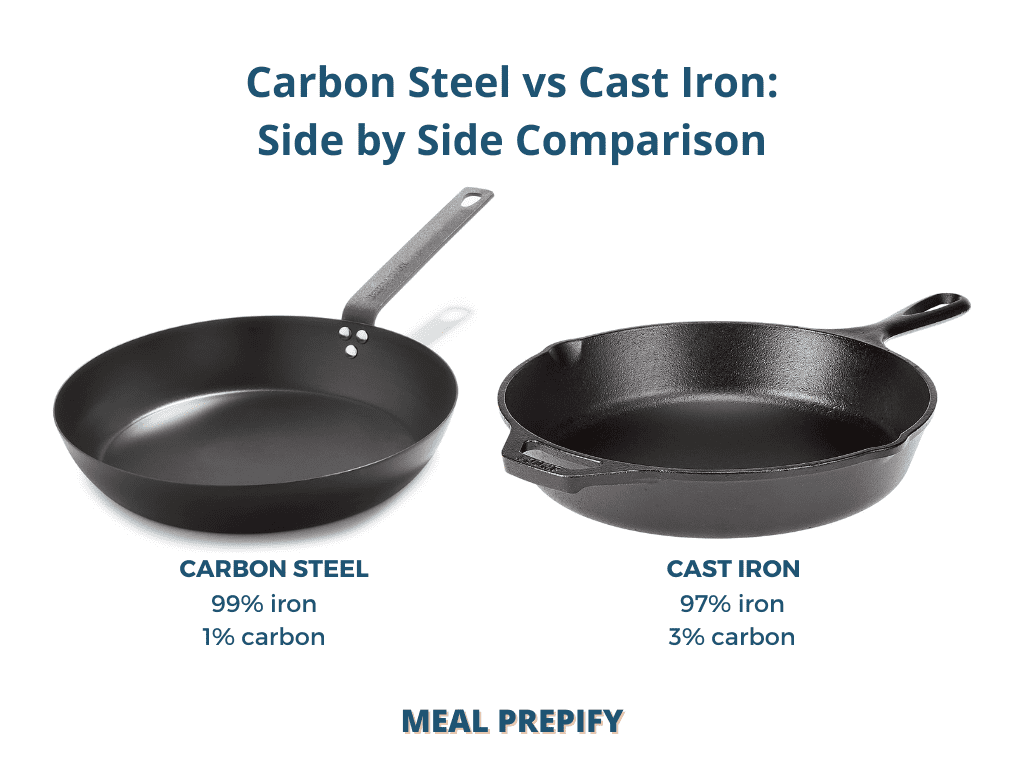Carbon Steel Pan vs Cast Iron: A Comprehensive Comparison
In the world of cooking, carbon steel pans and cast iron pans are both popular choices due to their durability and excellent heat retention. However, when it comes to choosing between the two, many people find themselves in a dilemma. In this article, we will provide an in-depth comparison of carbon steel pans and cast iron pans, highlighting their similarities, differences, and various aspects that can help you make an informed decision.

Carbon Steel Vs Cast Iron
I. Construction and Material:
Both carbon steel pans and cast iron pans are made from different materials and have unique construction methods.
A. Carbon Steel Pans:
1. Material: Carbon steel pans are constructed using a combination of iron and carbon.
2. Properties: They are known for their lightweight nature and quick heat responsiveness.
3. Versatility: Carbon steel pans are versatile and suitable for various cooking techniques.
B. Cast Iron Pans:
1. Material: Cast iron pans are made entirely of iron with a small amount of carbon.
2. Properties: They are heavyweight and take longer to heat up, but they retain heat exceptionally well.
3. Heat Distribution: Cast iron pans distribute heat evenly throughout the cooking surface.
II. Durability and Maintenance:
When comparing carbon steel pans and cast iron pans, it is crucial to consider their durability and maintenance requirements.
A. Carbon Steel Pans:
1. Durability: Carbon steel pans are relatively durable and can last for a long time if properly cared for.
2. Seasoning: Similar to cast iron, carbon steel pans require seasoning to develop a natural non-stick surface.
3. Maintenance: They require regular seasoning and thorough drying to prevent rust.

Fried eggs in cast iron pan
B. Cast Iron Pans:
1. Durability: Cast iron pans are renowned for their exceptional durability and can withstand high heat and heavy use.
2. Seasoning: Cast iron pans need to be seasoned to create a non-stick surface and prevent rusting.
3. Maintenance: They require regular seasoning, gentle cleaning, and thorough drying to maintain their seasoning.
III. Heat Retention and Performance:
Both carbon steel pans and cast iron pans excel in heat retention, but they differ slightly in terms of performance.
A. Carbon Steel Pans:
1. Heat Retention: Carbon steel pans heat up quickly and have excellent heat retention properties.
2. Cooking Performance: They offer precise heat control and are ideal for recipes that require quick temperature adjustments.
B. Cast Iron Pans:
1. Heat Retention: Cast iron pans are known for their unparalleled heat retention, which ensures even cooking.
2. Cooking Performance: They excel in recipes that require long, slow cooking and are perfect for searing and frying.
IV. Weight and Maneuverability:
The weight and maneuverability of cookware are important factors to consider for everyday use.
A. Carbon Steel Pans:
1. Weight: Carbon steel pans are lightweight compared to cast iron pans, making them easier to handle.
2. Maneuverability: Their lightweight nature allows for effortless tossing and flipping of ingredients.
B. Cast Iron Pans:
1. Weight: Cast iron pans are significantly heavier, which can make them challenging to maneuver, especially for some individuals.
2. Stability: The weight of cast iron pans provides stability during cooking.
Conclusion: When choosing between a carbon steel pan and a cast iron pan, understanding their construction, material, durability, heat retention, performance, and weight is crucial. Both pans offer unique advantages and are suitable for different cooking styles and preferences. Whether you opt for the quick heat responsiveness and lightweight nature of a carbon steel pan or the exceptional heat retention and durability of a cast iron pan, both will serve as excellent additions to your kitchen arsenal. Remember to consider your cooking needs and maintenance preferences to make the best decision that suits your culinary journey.